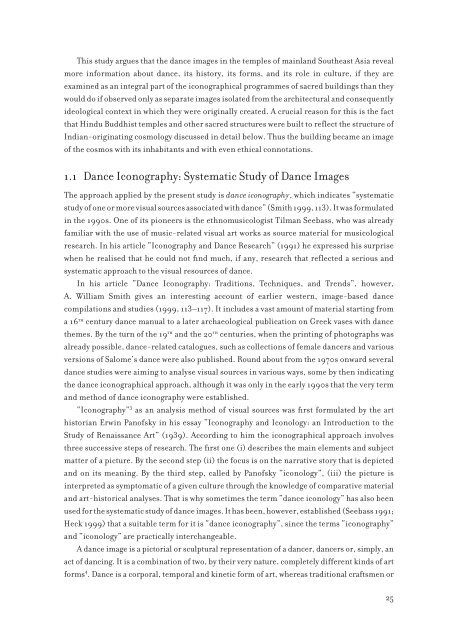Dance Images in Temples of Mainland Southeast Asia ... - Repository
Dance Images in Temples of Mainland Southeast Asia ... - Repository
Dance Images in Temples of Mainland Southeast Asia ... - Repository
Create successful ePaper yourself
Turn your PDF publications into a flip-book with our unique Google optimized e-Paper software.
This study argues that the dance images <strong>in</strong> the temples <strong>of</strong> ma<strong>in</strong>land <strong>Southeast</strong> <strong>Asia</strong> reveal<br />
more <strong>in</strong>formation about dance, its history, its forms, and its role <strong>in</strong> culture, if they are<br />
exam<strong>in</strong>ed as an <strong>in</strong>tegral part <strong>of</strong> the iconographical programmes <strong>of</strong> sacred build<strong>in</strong>gs than they<br />
would do if observed only as separate images isolated from the architectural and consequently<br />
ideological context <strong>in</strong> which they were orig<strong>in</strong>ally created. A crucial reason for this is the fact<br />
that H<strong>in</strong>du Buddhist temples and other sacred structures were built to refl ect the structure <strong>of</strong><br />
Indian-orig<strong>in</strong>at<strong>in</strong>g cosmology discussed <strong>in</strong> detail below. Thus the build<strong>in</strong>g became an image<br />
<strong>of</strong> the cosmos with its <strong>in</strong>habitants and with even ethical connotations.<br />
1.1 <strong>Dance</strong> Iconography: Systematic Study <strong>of</strong> <strong>Dance</strong> <strong>Images</strong><br />
The approach applied by the present study is dance iconography, which <strong>in</strong>dicates “systematic<br />
study <strong>of</strong> one or more visual sources associated with dance” (Smith 1999, 113). It was formulated<br />
<strong>in</strong> the 1990s. One <strong>of</strong> its pioneers is the ethnomusicologist Tilman Seebass, who was already<br />
familiar with the use <strong>of</strong> music-related visual art works as source material for musicological<br />
research. In his article “Iconography and <strong>Dance</strong> Research” (1991) he expressed his surprise<br />
when he realised that he could not fi nd much, if any, research that refl ected a serious and<br />
systematic approach to the visual resources <strong>of</strong> dance.<br />
In his article “<strong>Dance</strong> Iconography: Traditions, Techniques, and Trends”, however,<br />
A. William Smith gives an <strong>in</strong>terest<strong>in</strong>g account <strong>of</strong> earlier western, image-based dance<br />
compilations and studies (1999, 113–117). It <strong>in</strong>cludes a vast amount <strong>of</strong> material start<strong>in</strong>g from<br />
a 16 th century dance manual to a later archaeological publication on Greek vases with dance<br />
themes. By the turn <strong>of</strong> the 19 th and the 20 th centuries, when the pr<strong>in</strong>t<strong>in</strong>g <strong>of</strong> photographs was<br />
already possible, dance-related catalogues, such as collections <strong>of</strong> female dancers and various<br />
versions <strong>of</strong> Salome’s dance were also published. Round about from the 1970s onward several<br />
dance studies were aim<strong>in</strong>g to analyse visual sources <strong>in</strong> various ways, some by then <strong>in</strong>dicat<strong>in</strong>g<br />
the dance iconographical approach, although it was only <strong>in</strong> the early 1990s that the very term<br />
and method <strong>of</strong> dance iconography were established.<br />
“Iconography” 3 as an analysis method <strong>of</strong> visual sources was fi rst formulated by the art<br />
historian Erw<strong>in</strong> Pan<strong>of</strong>sky <strong>in</strong> his essay “Iconography and Iconology: an Introduction to the<br />
Study <strong>of</strong> Renaissance Art” (1939). Accord<strong>in</strong>g to him the iconographical approach <strong>in</strong>volves<br />
three successive steps <strong>of</strong> research. The fi rst one (i) describes the ma<strong>in</strong> elements and subject<br />
matter <strong>of</strong> a picture. By the second step (ii) the focus is on the narrative story that is depicted<br />
and on its mean<strong>in</strong>g. By the third step, called by Pan<strong>of</strong>sky “iconology”, (iii) the picture is<br />
<strong>in</strong>terpreted as symptomatic <strong>of</strong> a given culture through the knowledge <strong>of</strong> comparative material<br />
and art-historical analyses. That is why sometimes the term “dance iconology” has also been<br />
used for the systematic study <strong>of</strong> dance images. It has been, however, established (Seebass 1991;<br />
Heck 1999) that a suitable term for it is “dance iconography”, s<strong>in</strong>ce the terms “iconography”<br />
and “iconology” are practically <strong>in</strong>terchangeable.<br />
A dance image is a pictorial or sculptural representation <strong>of</strong> a dancer, dancers or, simply, an<br />
act <strong>of</strong> danc<strong>in</strong>g. It is a comb<strong>in</strong>ation <strong>of</strong> two, by their very nature, completely different k<strong>in</strong>ds <strong>of</strong> art<br />
forms 4 . <strong>Dance</strong> is a corporal, temporal and k<strong>in</strong>etic form <strong>of</strong> art, whereas traditional craftsmen or<br />
25

















